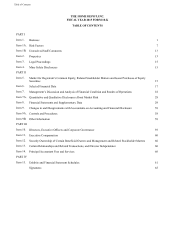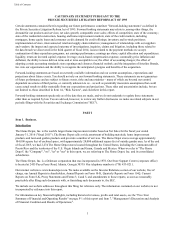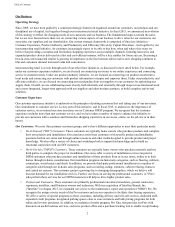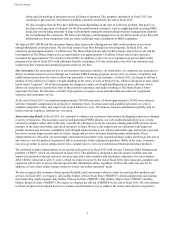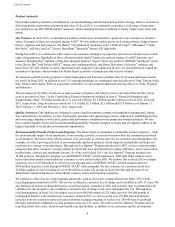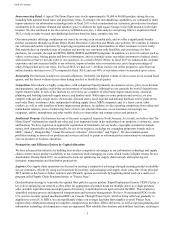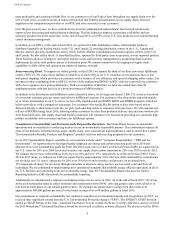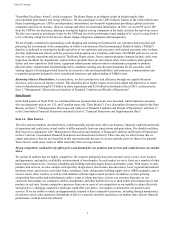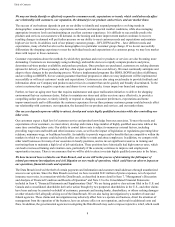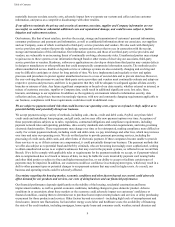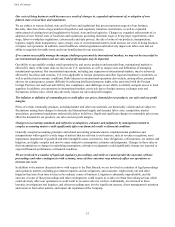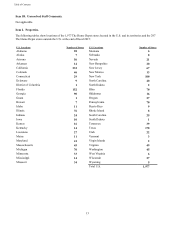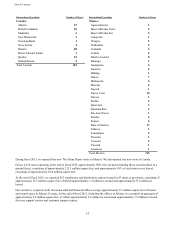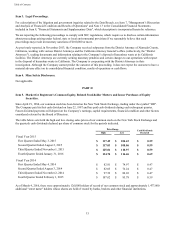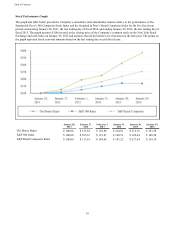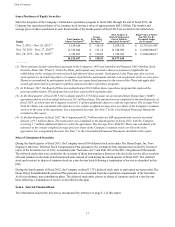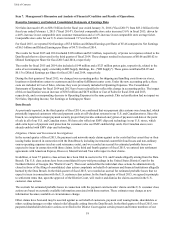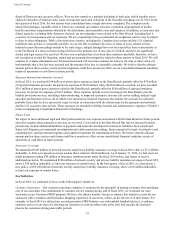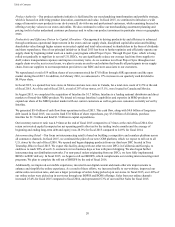Home Depot 2015 Annual Report Download - page 12
Download and view the complete annual report
Please find page 12 of the 2015 Home Depot annual report below. You can navigate through the pages in the report by either clicking on the pages listed below, or by using the keyword search tool below to find specific information within the annual report.Table of Contents
10
other conditions beyond our control – could further adversely affect demand for our products and services, our costs of doing
business and our financial performance.
A failure of a key information technology system or process could adversely affect our business.
We rely extensively on information technology systems, some of which are managed or provided by third-party service
providers, to analyze, process, store, manage and protect transactions and data. We also rely heavily on the integrity of,
security of and consistent access to this data in managing our business. For these systems and processes to operate effectively,
we or our service providers must periodically maintain and update them. Our systems and the third-party systems on which
we rely are subject to damage or interruption from a number of causes, including power outages; computer and
telecommunications failures; computer viruses; security breaches; cyber-attacks; catastrophic events such as fires, floods,
earthquakes, tornadoes, or hurricanes; acts of war or terrorism; and design or usage errors by our associates, contractors or
third-party service providers. Although we and our third-party service providers seek to maintain our respective systems
effectively and to successfully address the risk of compromise of the integrity, security and consistent operations of these
systems, we may not be successful in doing so. As a result, we or our service providers could experience errors, interruptions,
delays or cessations of service in key portions of our information technology infrastructure, which could significantly disrupt
our operations and be costly, time consuming and resource-intensive to remedy.
Disruptions in our customer-facing technology systems could impair our interconnected retail strategy and give rise to
negative customer experiences.
Through our information technology developments, we are able to provide an improved overall shopping and multichannel
experience that empowers our customers to shop and interact with us from computers, tablets, smartphones and other mobile
devices. We use our website both as a sales channel for our products and also as a method of providing product, project and
other relevant information to our customers to drive both in-store and online sales. We have multiple online communities and
knowledge centers that allow us to inform, assist and interact with our customers. Multichannel retailing is continually
evolving and expanding, and we must effectively respond to changing customer expectations and new developments. For
example, to improve our special order process we are currently rolling out COM, our new Customer Order Management
system, which our customers will be able to access online, and we continually seek to enhance all of our online properties to
provide an attractive user-friendly interface for our customers. Disruptions, failures or other performance issues with these
customer-facing technology systems could impair the benefits that they provide to our online and in-store business and
negatively affect our relationship with our customers.
If we fail to identify and develop relationships with a sufficient number of qualified suppliers, or if our suppliers
experience financial difficulties or other challenges, our ability to timely and efficiently access products that meet our
high standards for quality could be adversely affected.
We buy our products from suppliers located throughout the world. Our ability to continue to identify and develop
relationships with qualified suppliers who can satisfy our high standards for quality and responsible sourcing, as well as our
need to access products in a timely and efficient manner, is a significant challenge. Our ability to access products from our
suppliers can be adversely affected by political instability, military conflict, the financial instability of suppliers (particularly
in light of continuing economic difficulties in various regions of the world), suppliers’ noncompliance with applicable laws,
trade restrictions, tariffs, currency exchange rates, any disruptions in our suppliers’ logistics or supply chain networks, and
other factors beyond our or our suppliers’ control.
Disruptions in our supply chain and other factors affecting the distribution of our merchandise could adversely impact
our business.
A disruption within our logistics or supply chain network could adversely affect our ability to deliver inventory in a timely
manner, which could impair our ability to meet customer demand for products and result in lost sales, increased supply chain
costs or damage to our reputation. Such disruptions may result from damage or destruction to our distribution centers;
weather-related events; natural disasters; trade restrictions; tariffs; third-party strikes, lock-outs, work stoppages or
slowdowns; shipping capacity constraints; supply or shipping interruptions or costs; or other factors beyond our control. Any
such disruption could negatively impact our financial performance or financial condition.
The implementation of our supply chain and technology initiatives could disrupt our operations in the near term, and
these initiatives might not provide the anticipated benefits or might fail.
We have made, and we plan to continue to make, significant investments in our supply chain and technology. These
initiatives, such as Project Sync and COM, are designed to streamline our operations to allow our associates to continue to


